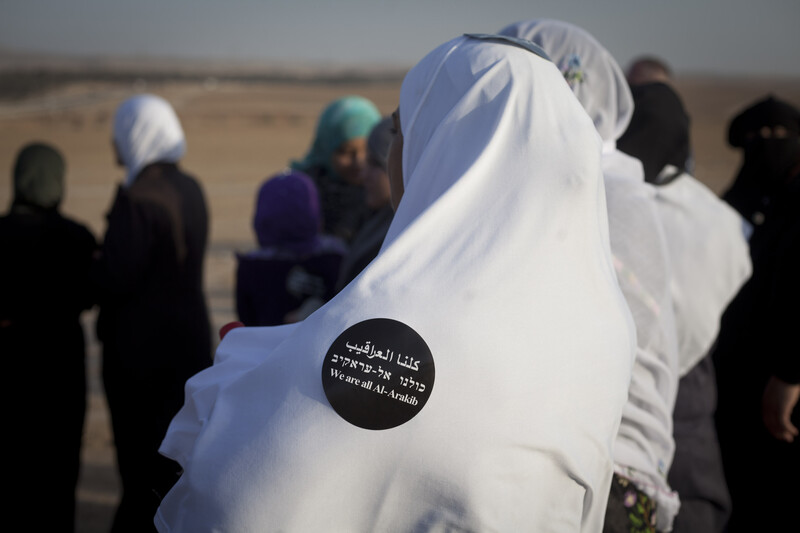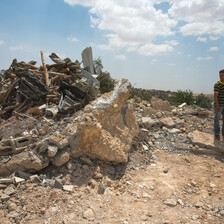The Electronic Intifada 1 October 2011

The Bedouin community in the Naqab (Negev) desert has remained steadfast in the face of property destruction and attempted displacement.
ActiveStillsWhile attention is focused on the Palestinian Authority’s UN recognition initiative, Israel is quietly taking hugely significant steps to transfer 30,000 Palestinian Bedouin in the Naqab (Negev) desert from their ancestral lands.
Recently, the cabinet of the Israeli government approved plans for another large-scale cleansing of the Bedouin community in the Naqab. The plan would “relocate” 30,000 of those who managed to remain on their land after more than two thirds of all Bedouin were uprooted during the establishment of Israel.
The Bedouin once were a flourishing community of some 90,000 persons who lived around the city of Bir al-Saba (Beersheva). Yet the expulsions that took place in 1948 were the prelude to their ongoing expulsion since then.
After the establishment of Israel, military rule was imposed on the Beersheva Bedouin for more than 18 years. Despite the end of the military rule in 1967, the Bedouin story of dispossession continues until today. Almost all their land was seized by the state using a set of legal maneuvers such as the absentee property law and the land acquisition laws of 1953.
Despite the expulsions that took place during the establishment of the State of Israel on their land, today the Arab Bedouin population is estimated to number more than 200,000 persons and constitutes one-third of the Naqab’s population. Today, half of Bedouin citizens of Israel live in 46 “unrecognized” villages. These are Bedouin villages in the Naqab which Israel does not recognize as legal; the villages are deprived of basic services like housing, water, electricity, education and health care. The rest live in townships that the state established for them in the 1970s in an aggressive policy of forced sedentarization.
Israel refuses to respect the rights of its own citizens; in this case 100,000 persons (the population of the 46 unrecognized villages) who are part of the 1.5 million Palestinian national minority treated as second-class citizens in Israel. Despite continuous policies since 1948 to Judaize the Naqab, Israel’s parliament, the Knesset, is currently considering the possibility of a final push to modify the demography of the region once and for all and hence tighten Israel’s control over it. The recent Goldberg and Prawer Commission recommendations of “relocating” 30,000 Bedouin from their native land was approved in September by the Israeli government (Eliezer Goldberg is a former Israeli high court judge; Ehud Prawer a senior Israeli civil servant; both men have headed panels set up to study the status of Bedouins in the Naqab).
Since 1948, successive Israeli governments have not dealt seriously with the Bedouin land ownership question, or “problem” in the Israeli state’s lexicon, in the Naqab. Successive new governments formulated new plans for dealing with the unrecognized villages and land claims. To this day, no government has applied universal principles of human rights to resolve the dispute between the Bedouin community and the state over land ownership.
It appears that Benjamin Netanyahu, the Israeli prime minister, is in the process of adopting extreme measures toward this segment of the Arab minority in Israel that remained within its historical homeland to achieve a final solution to this “problem.” The plan approved by the Israeli cabinet involves the expulsion and “relocation” of 30,000 Bedouins from their land out of a total of 100,000 residents of the unrecognized villages. It is no coincidence that such drastic measures are close to implementation.
With the regional shift in politics amid the Arab uprisings and the move towards recognition of a Palestinian state, Netanyahu’s coalition feels an urgent need to take the strategic decision of protecting space for Jewish settlers in the Naqab by dispossessing more indigenous Bedouin from their own historical land.
Land grab
The struggle between Israel and its Naqab Bedouin citizens is about a state bent on Judaizing the land by dispossessing its indigenous inhabitants, on the one hand, and indigenous land ownership rights, on the other. The land grab from the indigenous Bedouins started as early as 1949. By the 1950s, the majority of the remaining Bedouin (11,000) was expelled from the western part of the Naqab into a small enclosed military reservation north east of Beersheva (and became “internally displaced” citizens).
Since then, these remaining members of the community have consistently chosen to achieve land recognition through legal means in the Israeli court system. These cases are ongoing. The most recent case was that of the Bedouin village of al-Araqib. After years of legal discussions in the Beersheva district court, the land claims of the village were not recognized despite the fact that the residents of the village hold land deeds dating back to the times of Ottoman rule in Palestine. The response came in July 2010, when the Israeli authorities, accompanied by the Israel Lands Authority (ILA) and more than 1,300 police, demolished the village.
Since the initial razing of the village, and in an amazing display of steadfastness, the people of al-Araqib rebuilt their village with their own hands. In response, the state razed the village yet again, and as of the last destruction, the village has now been rebuilt on 29 separate occasions.
Such steadfastness has posed a fundamental challenge to an Israeli government seemingly unable to understand the nature of the people power unleashed in the region over the past nine months. The village’s plight has suddenly become the symbol of the land struggle between the indigenous peoples of the Naqab and the state.
Far-right sets the agenda
According to Turkish and British archival reports, previous governments in Palestine recognized Bedouin land claims. When Winston Churchill, the British prime minister, and Herbert Samuel, the first British High Commissioner for Palestine, met Bedouin sheikhs in 1921, they recognized Bedouin land ownership, according to specific customs and tribal laws. Yet since 1948, the Israeli court system has not recognized even one land claim, despite the fact that the Bedouin have made thousands of claims on their historical land.
In December 2007, Ehud Olmert’s administration established the Goldberg Commission, which was tasked with finalizing the status of Bedouin land claims in the Naqab. Nowadays, the Bedouin seek that 600,000 dunams (150,000 acres) of land is recognized and registered in the state registry as a small portion of their historical land. Today, the Bedouin populate approximately 5 percent of the Naqab’s land, a fraction of the area of southern Palestine they inhabited prior to 1948.
A report submitted in 2008 recommended that some of the Bedouin land be recognized. According to the Goldberg proposal, half of Bedouin claims on agricultural lands they currently occupy should be granted: around 200,000 dunams (50,000 acres) to be listed as Bedouin territory in the land registry bureau. In fact, this is less than half of the Bedouin land claims made since the 1970s. In addition, the Goldberg Commission recommended the recognition of a limited number of the unrecognized villages.
In January 2009, the government formed a team tasked with the implementation of these recommendations headed by Ehud Prawer, chief of the Policy Planning Department within the Prime Minister’s Office. The Prawer panel worked to implement Goldberg’s recommendations by offering 27 percent of the Bedouin claim. The Bedouin who are represented by the regional council of the unrecognized villages, and by other local and grassroots organizations, refused the offer.
The Bedouin argued that the Goldberg and Prawer recommendations would mean another catastrophe (Nakba) for them, with the loss of their land and demolition of most of their villages. The Bedouin campaigned against the Goldberg recommendations and asked for full recognition of their 46 villages and the all the land claimed by them.
In response to the possible implementation of the Goldberg recommendations, Yisrael Beiteinu, a right-wing party headed by foreign minister Avigdor Lieberman, urged the government to cancel the “offer” and reduce the amount of land to be recognized altogether. Right-wing members of the Knesset, and local Israeli council leaders in the Naqab, came out against a plan of dividing the Naqab.
Shmulik Rifman, head of Ramat Negev Council, stated that Netanyahu’s government was taking a major risk, explaining that if “they don’t finalize the Bedouin settlement it will be very hard to enhance Jewish settlement in the Negev. This must be addressed if one wants 700,000 Jews in the Negev.” From Rifman’s viewpoint, the Naqab and Bir al-Saba/Beersheva region is still central to the state’s ideology of colonizing more of the indigenous Bedouin land.
This pressure from Israeli right-wing politicians paid off. Modifications to the official recommendations of the Goldberg report were made, including the reduction of the amount of land available to Bedouin communities, as well as reducing the compensation offered to them in order to leave their land. The stance of the Israeli right-wing parties reflects the growing anxiety of the Israeli authorities to secure the Naqab for Jewish settlers. David Rotem, a Yisrael Beiteinu member of the Knesset, argued that “The occupation of state land has come to an end. We are returning the Negev to the state of Israel’s hands.” He also recommended employing 300 civil police to enforce what amounts to the state’s dispossession of Bedouin communities so as to stop their “encroachment” on “state” land and building “illegally.”
The struggle continues
Bedouins’ peaceful actions in the face of these policies of dispossession and expulsion are ongoing. The Bedouin campaign against the implementation of the Goldberg and Prawer recommendations includes organizing protests in Arab villages across the country and boycotting the government plans at different levels. Bedouin demonstration included organizing central demonstrations in Jerusalem.
But the local indigenous population are not willing to give up the claim to their land despite the continued weekly house demolition. The Bedouin continue to raise the banner, demanding their villages and land claims be recognized. The continually shifting policies of the state and its agencies towards the local indigenous Bedouin is a clear sign of their fear of losing more land for Jewish settlements in the Naqab, and it is a natural reaction to Bedouin steadfastness. The facts clearly indicate that indigenous peoples of the Naqab do not meekly submit to state oppression, and that they are not going away.
Editor’s note: an earlier version of this article and its headline incorrectly stated that the Knesset approved the transfer plans. The Knesset has not yet voted on this.
Dr. Mansour Nsasra teaches Middle East politics and international relations at the University of Exeter.


